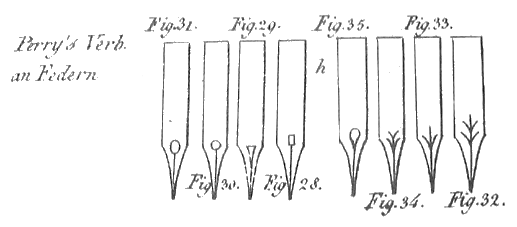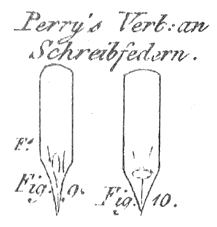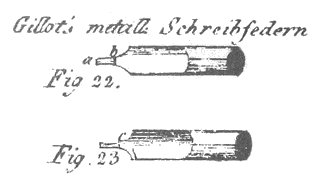
In England, where both the consumption of quills and the technical level were very high, industrial steel nib production began. In the 1920s, up to six million quills were cut annually in a large London banking house, and only one in ten of these was "re-sharpened" after being used. The quills, which were only used once, were bought up by hucksters and resold.

In about 1822, it is believed, John Mitchell began punching nibs out of thin sheet steel by machine.
In 1830, James Perry, a bookseller, was granted a patent for making holes or incisions of various shapes in the end of the beak (the split tip), and in 1832 for slitting in the side (at the "shoulder").
In 1831, Joseph Gillott replaced the wedge-shaped tip with an elongated one, and the beak was now formed by two parallel, straight pieces. Thus, the steel nib has not yet reached the flexibility of the goose quill, but it can compete with it.

Further technical improvements, but also the cheap letter postage of the "penny post" (1840) contribute to the popularization of the steel nib.
Joseph Gillott's factory in Birmingham produced over seventy million in 1842 alone, and over a hundred million in 1843. At the beginning of the 1950s, when the first German steel nib factory was founded, it produced over one hundred and eighty million - of the approximately five hundred employees, four hundred were women.
It was only in more recent times that the steel nib came into existence. Its influence on the transformation of the handwriting is already evident since the short time of its use. The peculiarities of the character, which were still expressed in the writing with the goose quill, disappear more and more. The goose quill was cut by the writer from the raw quill and adapted to personal need or habit, while the steel quill, a million product of the factories, forces the hand to conform to it. Through it, not only have the various "ducts" disappeared, but also the small individual diversities are grinding away. Soon one person will write like another.
The new book of inventions, 1872

Since the nib, lightly guided when writing, produces a perfectly even handwriting, the use of the steel nib can therefore be recommended to every writer with complete conviction. Anyone who, when writing with a steel nib, uses a thick, smooth paper base, any liquid ink and no excessively rough paper, rests the forearm more than halfway on the table and gets into the habit of holding the nib flat, will, even if he has never held a steel nib in his hand before, decide to use it constantly within the first hour.
Carl Kuhn & Co, Wien, on the back-side of a steel pen nib box